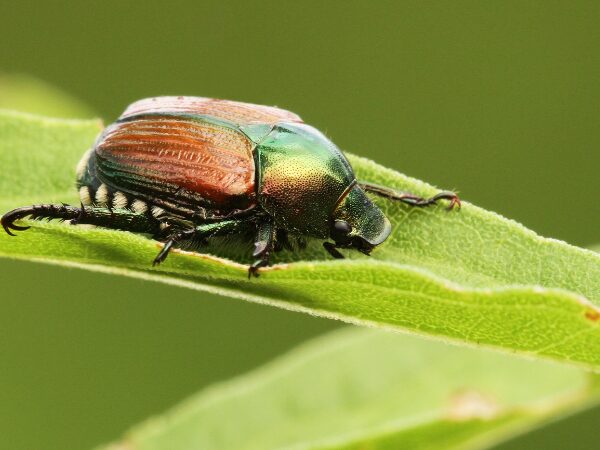
Japanese Beetles
Japanese beetles are highly destructive plant pests, causing damage both as adults and grubs. Adult beetles feed voraciously on the foliage and fruit of numerous plant species, including ornamentals, fruit trees, shrubs, vegetables, and field crops. Their feeding habits leave behind skeletonized leaves, damaged flowers, and large, irregular holes in foliage. The beetles begin their life as white grubs in the soil, where they feed on the roots of grass, often resulting in the destruction of lawns.
What do Japanese Beetles Look Like?
Adult Japanese beetles are oval-shaped, about 1 cm (½ inch) long, and easily recognized by their metallic green bodies and bronze wing covers. Along each side of their abdomen, they have six distinctive white tufts of hair, which help differentiate them from similar-looking beetles.
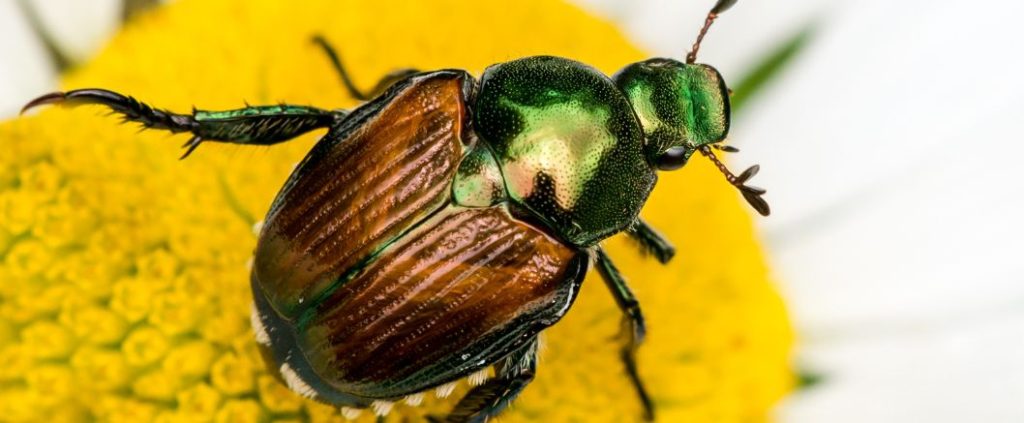
The Damage They Cause
Japanese beetles are relentless feeders that can cause significant damage to a wide variety of plants in a short amount of time. Adult beetles feed on leaves, flowers, and fruit, often in large groups, and are most active during warm, sunny days. One of the telltale signs of their presence is skeletonized foliage—they eat the soft tissue between the veins of leaves, leaving behind a lacy, see-through pattern.
You may also notice:
- Chewed flower petals, especially on roses, hibiscus, and zinnias
- Browning and withering leaves, even while the plant is still well-watered
- Clusters of beetles feeding together, usually in the morning or evening
- Grub damage in lawns, where larvae feed on grassroots, causing patchy, yellowing areas that lift easily like sod
Left unchecked, Japanese beetles can weaken plants, reduce flowering and fruit production, and even kill young or stressed specimens over time. Early identification and consistent action are key to minimizing their impact.
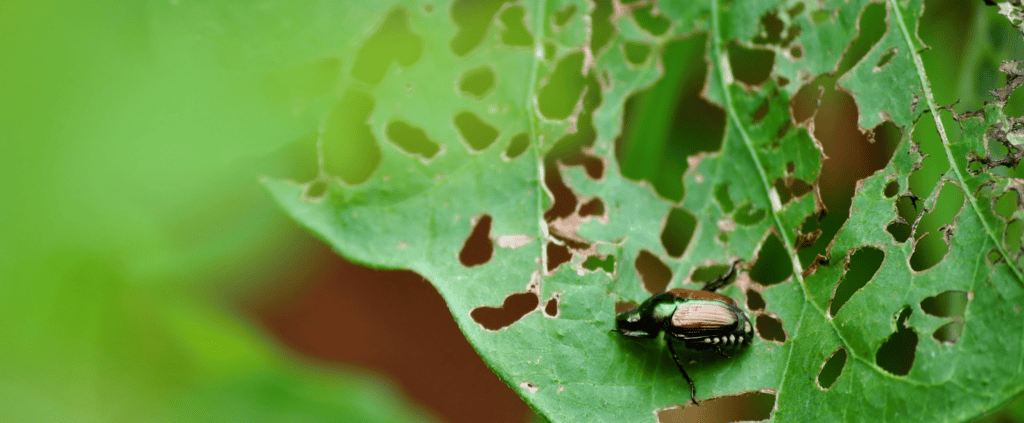
Japanese Beetle Life Cycle
During the summer, female beetles intermittently leave their host plants to burrow about three inches into the ground, usually in lawns, to lay a few eggs. This process is repeated until the female has laid between 40 to 60 eggs. By midsummer, the eggs hatch, and the young grubs begin to feed. Each grub grows to about an inch long and curls up in the soil. In late autumn, the grubs burrow 4 to 8 inches deeper into the soil to remain inactive throughout winter. In early spring, the grubs return to the turf and resume feeding on roots until mid-June, when they transform into pupae. Approximately two weeks later, the pupae become adult beetles and emerge from the ground. This life cycle spans one year.
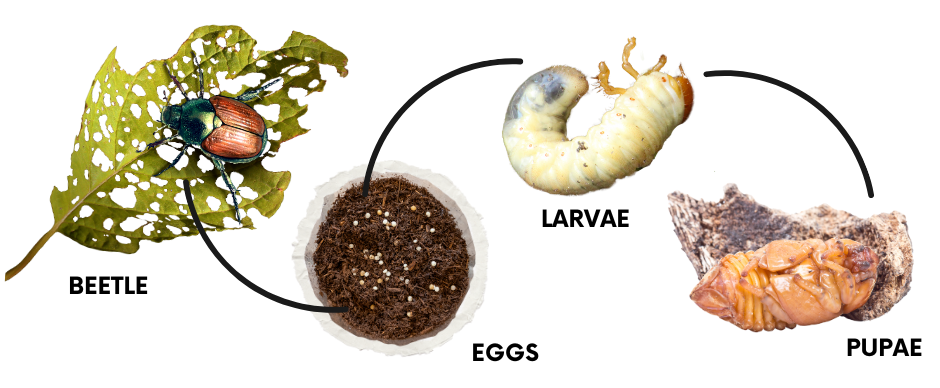

Plants Japanese Beetles Love to Eat
Trees & Shrubs:
- Roses
- Grapevines
- Linden (Basswood)
- Crabapple
- Japanese Maple
- Birch
- Norway Maple
- Horse Chestnut
- Cherry
- Plum
- Apple
- Sassafras
- Crape Myrtle
Perennials & Annuals:
- Hibiscus
- Hollyhock
- Evening Primrose
- Dahlias
- Tuberous Begonia
- Clematis
- Cosmos
- Zinnias
- Sunflowers
- Peony
- Rudbeckia (Black-Eyed Susan)
- Marigolds
- Boston Ferns
- Kimberly Queen Ferns
- Cana Lilies
- Morning Glory
Fruits & Vegetables:
- Beans
- Peas
- Corn (especially silks)
- Raspberry
- Strawberry
- Tomato
- Asparagus
- Rhubarb
- Basil
How to Control Japanese Beetles
Japanese beetles have become a persistent summer pest in our region—and unfortunately, they’re not going anywhere. With Ontario’s cosmetic pesticide ban, traditional chemical sprays are off the table, but that doesn’t mean we’re powerless. By focusing on safe, effective strategies, you can protect your plants and reduce beetle damage significantly. From targeting grubs in the soil to physically removing adult beetles and using smart planting techniques, here are five proven ways to keep your garden thriving through beetle season.
1. Grub Control – Beneficial Nematodes
Treating the soil before beetles emerge is one of the most effective long-term defences. Beneficial nematodes (Heterorhabditis species) can be applied in spring or late summer, targeting the grub stage of Japanese beetles before they mature. For best results, apply when the soil temperature is consistently above 10°C, typically mid-to-late April or mid-August through late September, when grubs are active near the surface. These microscopic worms seek out and infect beetle larvae in the soil, preventing them from becoming the leaf-munching adults we see in summer. Water thoroughly before and after application, and apply at dusk to protect the nematodes from sunlight.
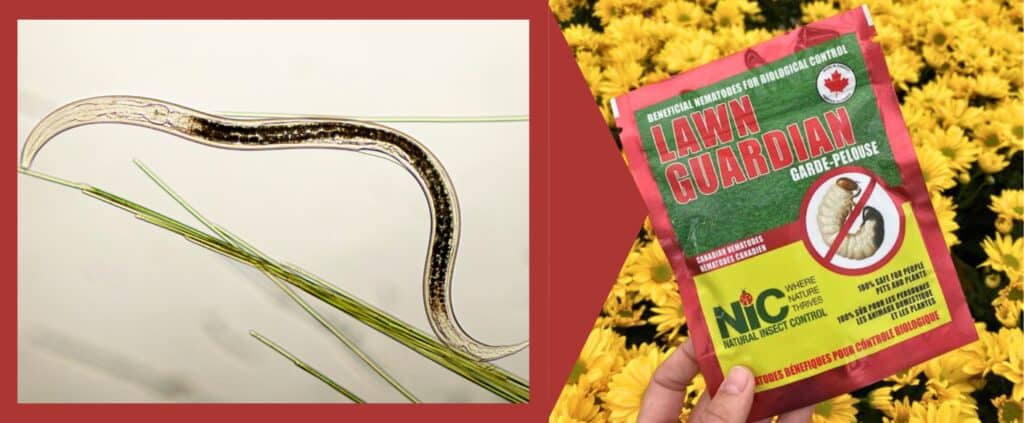
2. Hand-Pick & Dunk
Japanese beetles are sluggish at dawn and dusk. Slip a jar or bucket of soapy water under each cluster and tap the branch; the beetles drop straight in and drown. A few minutes of “bucket duty” every day during peak season (late June–early August) can dramatically reduce feeding damage—especially on high-value plants like roses and grapes—without violating Ontario’s cosmetic-pesticide ban.
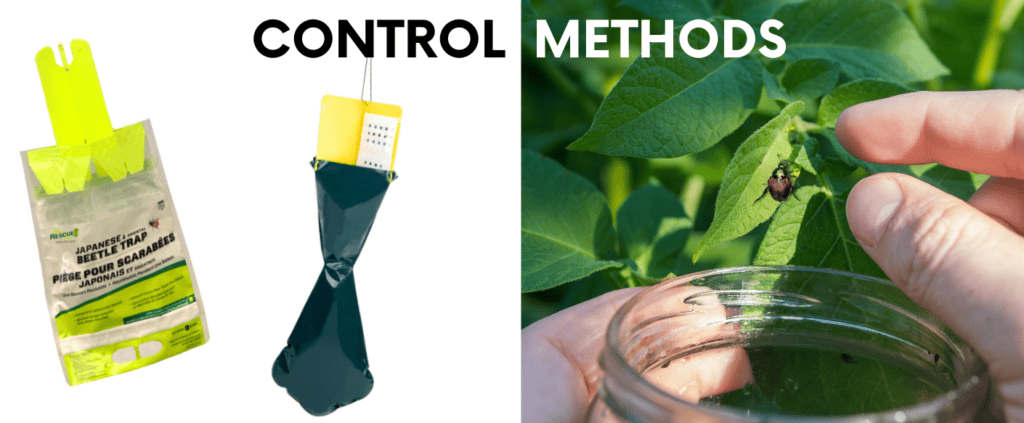
3. Pheromone Traps – USE WITH CAUTION
Commercial traps lure beetles with a floral scent plus a sex pheromone. They work—but they also attract extra beetles, so place traps along the property edge or well down-wind of prized beds, not beside them. Empty the catch bag before it overflows, and replace lures every 4–6 weeks. Traps are most useful when combined with hand-picking and grub control.
4. Companion Planting
Planting with intention can go a long way in deterring Japanese beetles. Interplant your ornamentals with natural repellents like garlic, chives, catnip, basil, lavender, rue, mint, chrysanthemums, and lemon balm—all known for their strong scents and compounds that beetles tend to avoid. For added protection, try a push-pull approach by placing highly attractive “decoy” plants like four-o’clocks, zinnias, hollyhocks, or scented geraniums along garden edges. Once beetles cluster on these plants, you can remove or treat them separately—helping to keep your roses, fruit trees, and other prized plants safe in the centre of your yard.
Herbs & Strongly Scented Plants:
- Garlic
- Chives
- Catnip
- Mint
- Oregano
- Thyme
- Lavender
- Rue
- Lemon balm
Shrubs & Perennials:
- Boxwood
- Lilac (Syringa)
- Forsythia
- Hydrangea (some varieties)
- Smokebush (Cotinus)
- Butterfly Bush (Buddleia)
- Redbud (Cercis canadensis)
- Astilbe
Flowers & Ornamentals:
- Chrysanthemums
- Foxglove
- Larkspur
- Bleeding Heart
- Coral Bells (Heuchera)
- Columbine (Aquilegia)
- Hellebores
Grasses & Groundcovers:
- Ornamental grasses
- Pachysandra
- Vinca minor
- Lamium
- Sweet Woodruff

5. Physical Barriers
During the six-to-eight-week adult flight window, drape fine mesh or floating row covers over susceptible shrubs, veggies, or fruit crops. Secure the edges so beetles can’t crawl under, and lift covers briefly when crops need pollination. Netting also protects young foliage from hail and sun-scorch—an added bonus in a sizzling Southwestern Ontario summer.
Protecting your garden from Japanese beetles requires diligence and the right strategies. By combining physical removal, grub control, and the use of traps, you can significantly reduce the impact of these pests on your plants.

